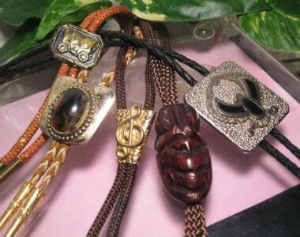
Welcome to the Bolo Tie Shop

The Place to Discover and Share All About Bolo Ties!
Hi, I'm Crystal I (obviously) love Bolo Ties. I'm passionate about dressing great and all that is fashionable with neckwear especially Bolo Ties!
Bolo Ties are the Best-Selling Neckwear!
With the Bolo Ties being the #1 best-selling neckwear items on eBay there's a real need for a friendly, easy-to-use website about these unique ties.
That need is continuing to grow with Antique Bolo Ties to Turquoise Silver Bolo Ties and Western Bolo Ties. I've seen countless Native American Bolo Ties which are just stunning and really say something about your style.
Stay and discover fabulous:
- designs, tips, and information
- the best Bolo Tie categories, accessories, and collections
- other resources for getting the best look out of your Bolo Tie!
What are Bolo Ties?
Bolo ties are a piece of neckwear designed from a cord or string, usually leather, which closes at the throat with a decorative brooch. Other names for this well-known neckwear are bootlace ties, and string ties. The terms refer to the tapered width of the cord used to create the tie. Bolos are especially linked to the American Southwest, even though they every so often appear on the fashion scene; however, they never loose their distinctiveness. Bolo ties are what they are, and there's no other tie that comes close to replacing it. Numerous Western retail outlets stock this type of tie wear including stores, on and off the Internet that exclusively sell Western attire.
The brooch, or clasp, of the bolo tie is straightforward whenever adjustment is required. In fact, many believe that the position of the clasp determines the milieu of the moment. The higher up the clasp, the more formal the setting. The tie is commonly worn atop a crisp button down shirt. Some wearers prefer to match the brooch with a belt buckle for particular events.
History of Bolo Ties
The characteristic bolo tie originated in the Southwest. Its prevalence rapidly widened throughout the West including other parts of the country as well. The unusual necktie has been increased in adoration due to the artistry of contemporary American Indian artist in the state of Arizona. Their ties are known for their lovely expressions of individuality and originality.
Rumor has it that while World War II surged forward, the dimension and complexity of cravats was traded for the clear-cut necktie. This opened the way for the American addition to menswear. An Arizona silversmith named Victor Cedarstaff, slipped a silver-trimmed strip around his hat. Through fear of mislaying the strip, or band, due to his hat persistently slipping off, Cedarstaff knotted the band around his neck collar. An acquaintance commented, "hey, that's a good-looking tie you're wearing there, Vic," according to an Arizona newspaper. Cedarstaff soon created the first "bola tie," which stems from the word "boleadora," or an Argentine lasso. Victor Cedarstaff was the first to patent the slide design of the bola tie. Read more on Bolo Tie History and Celebrities who wear them.
Types of Bolo Ties
The variations of bolo ties have plenty to do with its origins. For example, the Southwestern USA asserts dominion over the Indian and western bolo tie adaptations including stones of the territory and by amalgamating Native American silversmith customs.
Argentina is attributed responsibility for using three leather straps, also known as the "lariat style." Afterwards, the British variety came on the scene labeled bootlace ties. These ties consisted of fabric or leather laces that may be multicolored or black. People regard them as costume attire, though trendy "Teddy Boys" wore them during the 1950s.
Bolo Ties Today
Bolo ties increased in popularity in the 1950s through TV show and movies via famous personalities during that time such as Hopalong Cassidy, Roy Rogers, and Cisco Kid. Still today, American Indian jewelers create bolo ties. Bolo ties graced the big screen through the decades, most conspicuously in the film "Urban Cowboy" in 1980. The "Stray Cats" rockabilly band modernized bolo ties once again in the mid-1980s, in addition to the New Romantic Boys who wore an Edwardian collared chemise completing the outfit with an archaic suit coat. The movie "Pretty in Pink" was another Hollywood take on the bolo ties unique and elegant style.
As recently as 2012, bolo ties have caught on in Japan. For example, girls in Tokyo have been creating their own variations by wearing shoestring ties and ties around turtlenecks or blouses. A tremendous variant on the sorts of clasps and slides worn has become quite popular as well. Widespread clasp styles include initials, letters, and skulls, even though in the United States the traditional clasp has the most influence.
While bolo ties are traditionally worn similar to standard ties, around the collar of a button-up shirt, it seems that the modernized repetition of shoestring ties can be shown off as a cliched necklace instead! Bolo ties have never died. They are just as traditional as the western cowboy hat itself. In fact, the western cowboy hat and the bolo tie are a match made in style-paradise. The look is one of sophistication and casualness modestly mixed together.
If you have bolo ties tucked away somewhere, now is the perfect time to bring them out according to the fashion experts of the day! Nonetheless, the finest Contemporary Anglo and Native American jewelers handcraft creations are still considered the finest you can buy. These are sold in galleries and the best museum shops around the United States.